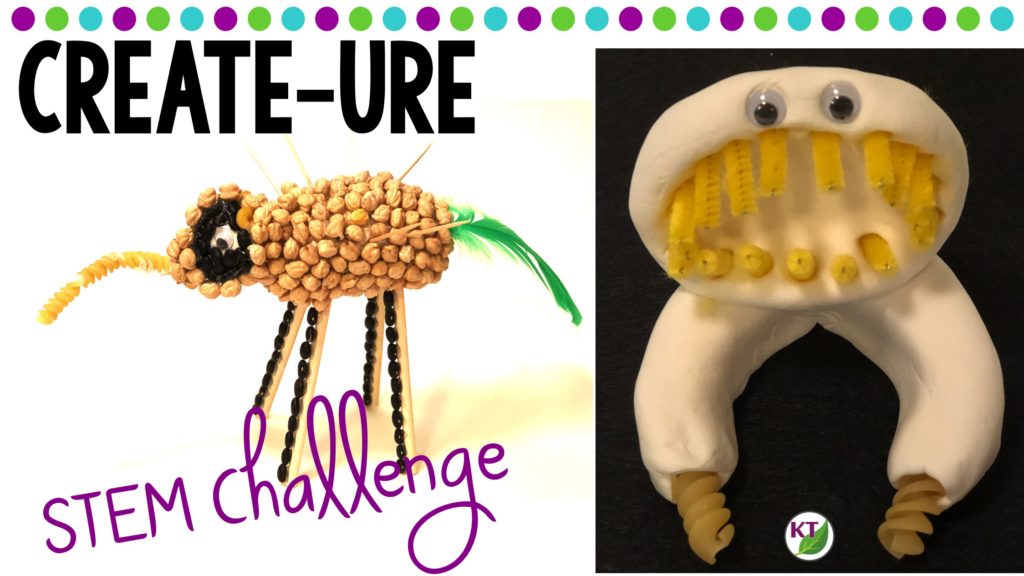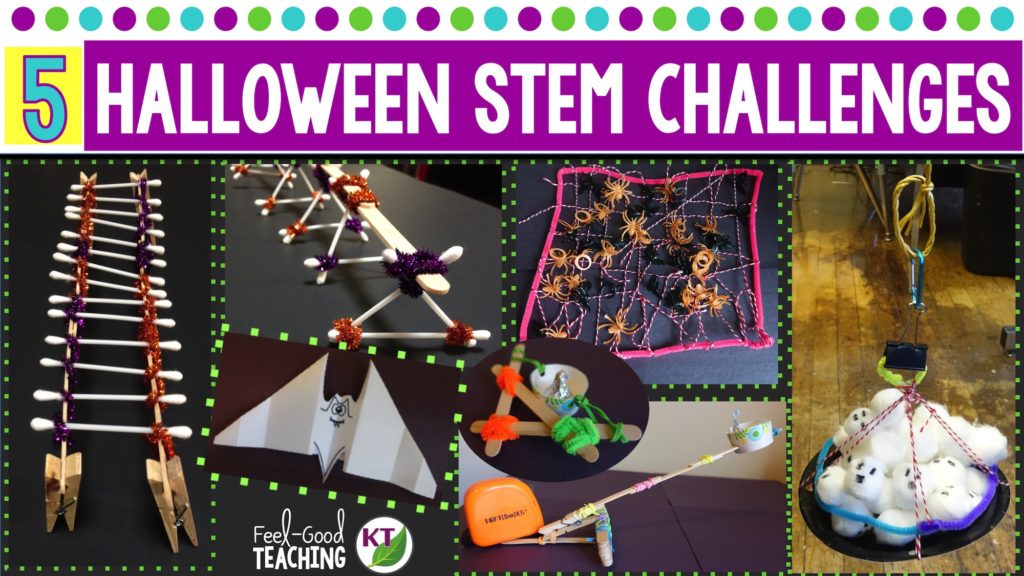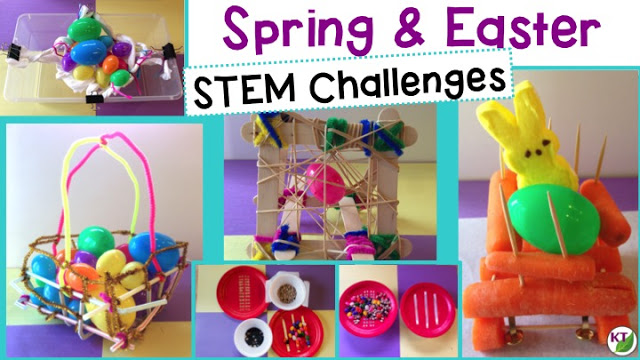If you’re looking to apply learning in adaptations, habitats, food chains and food webs, life cycles, genetics & heredity, evolution, and/or human body systems, this STEM / STEAM challenge is a student-favorite way to get the job done joyfully!
The Basics
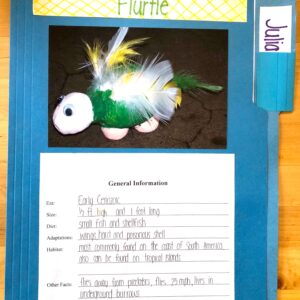
In this STEM/STEAM Challenge students will design a “create-ure” that has never been seen before — in real life or imaginations (no mythological beasts)! Of course it’s totally fine to combine features from other animals in a brand new way. Students become very attached to their designs, so it’s best to do this one individually. Another option is to have them design with a partner or group, where each person makes a version of the same create-ure: male/female, adult/baby, dominant/recessive traits, stages of the life cycle, etc.
Materials:

IIt doesn’t have to be as complicated as what you see below. I’ve done this challenge successfully with nothing but newspaper, tape, and pipe cleaners. But with any challenge, the greater variety in materials results in greater variety in the designs.
For each student/group:
- Crayola Model Magic
- Newspaper or tissue paper
- Construction paper
- Craft sticks
- Pipe cleaners
- Sequins
- Yarn
- Pom poms
- Googly eyes
- Paint
- Feathers
- Toothpicks
- Scissors
- Foil
- Cotton
- Felt
- Sand paper
- Glue
- Masking tape
- Hot glue guns
- Plastic wrap or sandwich baggies
- Uncooked noodles, rice, and/or beans
- Design analysis handouts (included in resource)
Video Walk-through
The video below walks you through all the steps of this STEM/STEAM Challenge from materials, set-up, modifying the Criteria & Constraints list for your students, measuring results, and lots of extension ideas. If you have any questions after watching, let me know in the comments. If you prefer reading to watching, you’ll find the transcription at the end of the post.
Save Some Time!
In the video, you’ll get all the basics and more to run this challenge. In the resource, I’ve put together all the design analysis, extension templates, and given you even more extensions from which to choose. I can tell you, it was a LOT of time and effort put into this labor of love! Why not skip all the heavy lifting and treat yourself to a STEAM Challenge that’s ready to print & go?! You’re worth it! 🙂
I
Pin Me
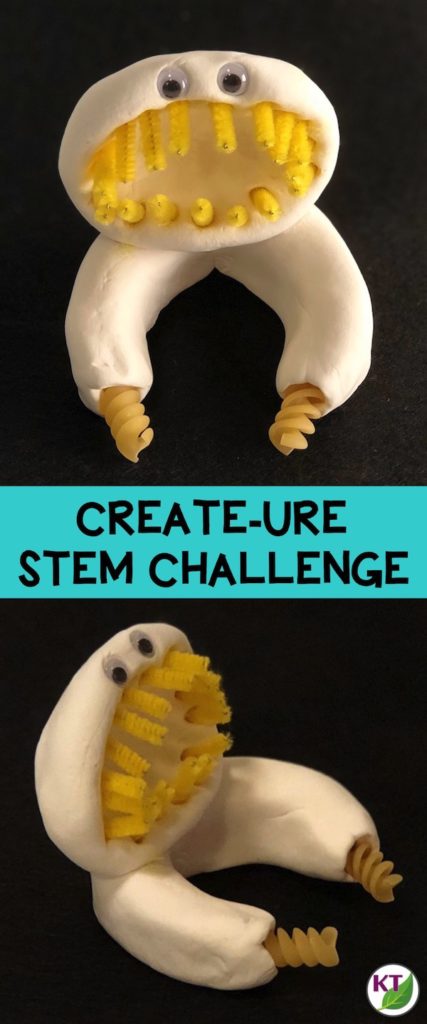
Transcription
Hi! It’s the very best day of the week, Stem Challenge Day! And today I have a brand new challenge for you. It’s called “Create-ure.” This is one I usually do in the springtime, but it occurred to me it’s also perfect for Halloween, so I thought I would try to get it out in time for that. Before I get too far ahead of myself, let’s check out the materials and the Stem/STEAM Challenge cycle.
This is the Stem Challenge cycle you should follow for every challenge. I’ve defined each step in another video. I’ve added a popping card to that video here as well as a link in the description.
0:30
You definitely don’t need to provide all the things you saw in the materials photo. I’ve done this challenge with nothing more than newspaper, masking tape, and pipe cleaners, and I’ve also done it when I’ve gone all out and used quite a few of the things that you did see in the photo.
While Model Magic is one of my most favorite materials to use for this challenge, it’s also a bit pricey, so if you could get some parent donations, I would say definitely use it. Some of the benefits are that it’s very lightweight, you can paint it, you can use markers on it, glue adheres pretty well to it … in fact, it’s so light that in the past, I’ve been able to fold up a 4×6 index card and then put it on the bulletin board and it’s actually been able to support the weight of quite a few of my students’ Create-ures.
You can decide ahead of time if you want to share tips with students, like using a toothpick to connect the head to the body for a little bit of extra support, or you can use that to them as part of the problem solving and engineering within the challenge.
Students become very attached to their Create-ures, and for that reason, I recommend that this challenge is either done individually or in partners. If you choose to do partners, the students should still be creating their own creature. Have one person create the female and the other the male of the species. You could also do adults and babies, dominant traits versus recessive traits; or you could also let your students choose which ones to do. You could form small groups with this challenge and have each person in the group form a different stage of that creature’s life cycle. I just recommend that whatever you choose to do, each individual student is getting to make their own version of their Create-ure.
2:01
The criteria and constraints list starts pretty simple here. The students are to create a 3D living Create-ure, and it needs to have a way to protect itself from its climate and from other predators, and it needs to have a way to move and to get energy. Other than time and materials, the main constraint is that the Create-ure must be never-before-seen, so it can’t be an animal that has existed at any point in history, nor can it be a creature that exists in mythology or someone’s imagination. No unicorns. If that stumps your students, let them know that it’s perfectly okay to take some features from different creatures and put them together in a brand new way.
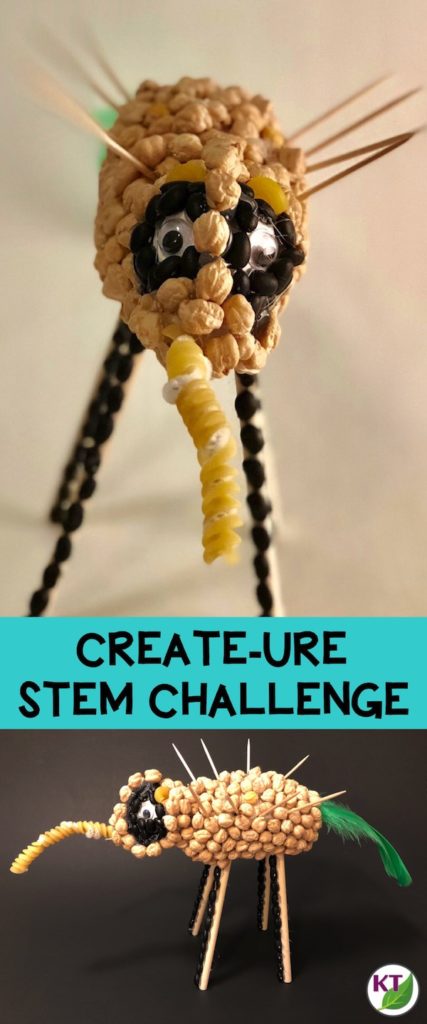 If you’re looking to increase the difficulty, you can add in a few criteria and constraints. One thing you can ask is that the students make sure that the Create-ures are able to support their own weight or stand on their own, as you see all of these are doing right here, right now. I don’t have to lean it up against anything; I’m not holding on to it.
If you’re looking to increase the difficulty, you can add in a few criteria and constraints. One thing you can ask is that the students make sure that the Create-ures are able to support their own weight or stand on their own, as you see all of these are doing right here, right now. I don’t have to lean it up against anything; I’m not holding on to it.
Another thing you can do is assign a certain region or climate to each group and have them create a Create-ure that’s perfectly suited for that environment. I typically avoid that one because I find it limits students in a way that doesn’t particularly inspire them. I sort of prefer to go the reverse route, which is they create the Create-ure and then figure out what is the perfect climate and habitat for that creature. If you have older students, you might also consider incorporating some sort of close-up, like functional joints or some type of movement involved with the creature itself.
3:30
To measure results on this, you can either have students give a simple yes or no that they met all the criteria and constraints of the challenge within their Create-ure, or you could have them jot down how exactly they met each of the criteria and constraints.
Let’s talk about extensions, because there are so many great ones to use here. One thing I like to do is a little mini file folder project. You could have the students either take a photo or they could even just draw a picture of their Create-ures, and then they put some basic information here in this section. Where does the creature live? What is its size? What is its diet? Also, what are its adaptations? This one is an example from the seventh-grade class, so I also had them identify which geological era did their creature come into being. They have to justify that information. How did they choose that? It can’t just be a random selection.
As you can imagine, students are engaged in lessons on geological eras in a much different way than they would be if they weren’t trying to evaluate in which one their Create-ure belongs. This increased engagement is true of all the standard space lessons that you connect back to something that they care about and that’s physically in the classroom.
4:42
During this time period you’re also doing some review of genetics and heredity, so we have some recessive and dominant trait identification as well as some Punnett squares crossing parents to see what their offspring would look like. And in this year we also did a cladogram. You can certainly add pages or use different things. For example, you could have students create food webs with their Create-ures and also others within the class, and even mix in actual creatures that exist today.
Once the students have had an opportunity to share and present to their classmates, they should have a short period of time where they try to put themselves into families or groups based on common features. These should be common features to their actual Create-ures and not to the materials you use. For example, I might say these two are in a family because they live in the ocean. I would not put these two in a family simply because they both use pasta shells.
And don’t tell the students how they should classify themselves. Tell them to simply look for other groups that belong with theirs, and then have them explain why they say so. It could be about the diet, it could be compound eyes or the body covering; however they choose to do it is not for you to worry about. Just give them about 30 seconds to get into a group. Ask each group to explain what it was that their Create-ures had in common, and then tell them, “Find a new group.” Repeat that a few times. It’s pretty quick, but it’s really interesting to see what they come up with.
And of course, if you want to involve some ELA, have the students do some descriptive writing or even narrative stories involving their Create-ures.
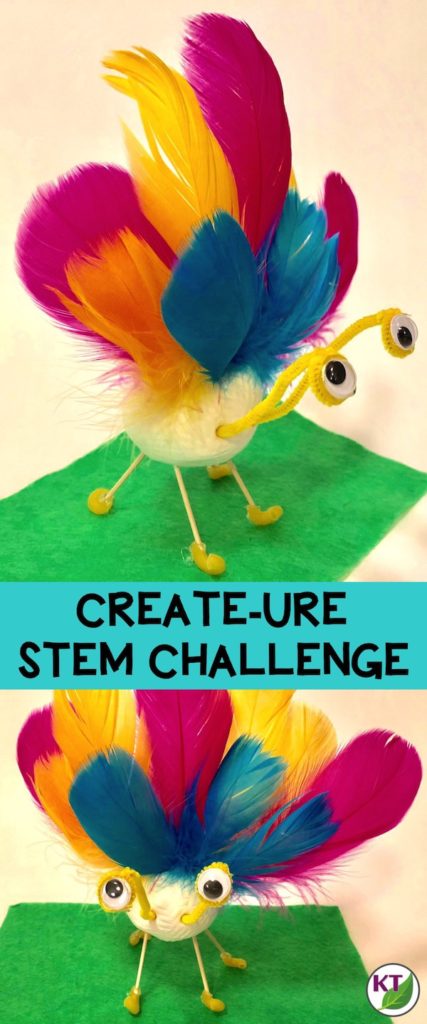 6:14
6:14
You have everything you need to conduct this Stem/STEAM Challenge in your class on your own, but if you’re looking to save oodles of time, check out the resource.
This resource contains everything you need to guide your students through the Create-ure challenge, including modifications for you for second through eighth-graders. You’ll still need to gather the materials, of course, but the rest has been done for you. You’ll get alignments and science standards, links to my Stem Challenge how-to videos to help you get the most from each challenge, and the Create-ure materials list.
In Teacher Tips you’ll find premise and setup, how to increase or decrease difficulty through the criteria and constraints list, measuring results in cross-curricular extension suggestions. You’ll find an editable criteria and constraints list so you can tailor the challenge to your students.
6:53
For student handouts there are two versions. Four page expanded room for response for younger students and a two-page condensed space paper saver version. You’ll also find a set of group discussion questions. In the extension handouts you’ll find templates to make Create-ure booklets or folders focusing on adaptations, habitats, life cycle, food webs, classification, genetics and heredity, evolution, and a set of compare-contrast templates for human body systems. You’ll also get map extension and processed flow templates.
This STEAM challenge is available individually and is part of the discounted mega Stem Challenge bundle coming in 2018, and we’ll also be part of a new discounted spring bundle and an additional paperless version. Links can be found in the description below the video.
I can’t wait to see what your students create. If you take any photos, please tag me on social media or send them to me in a video, [email protected]. I hope your week is packed with feel good teaching moments. See you next time.


